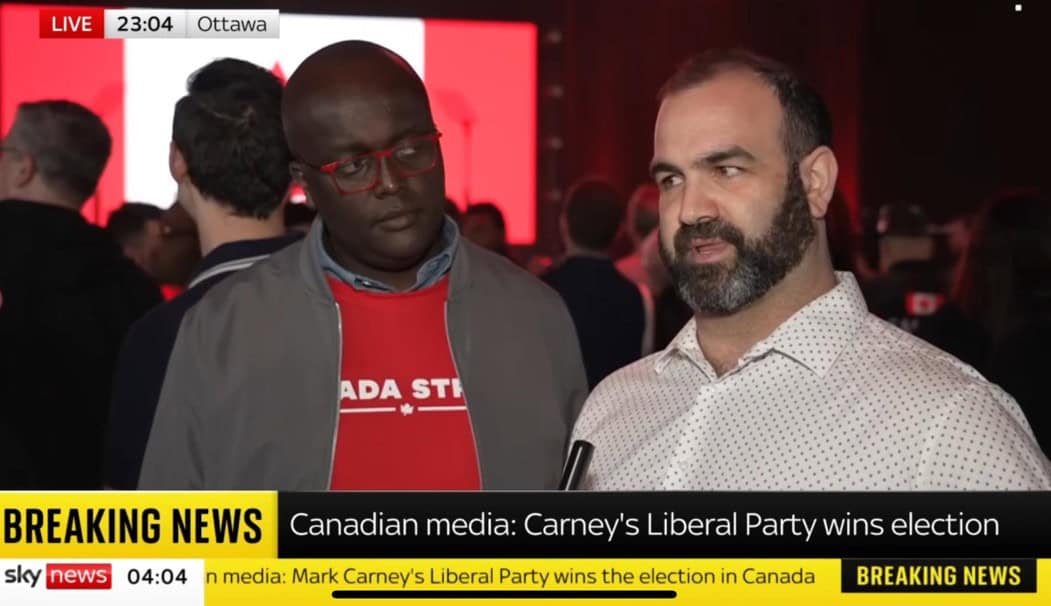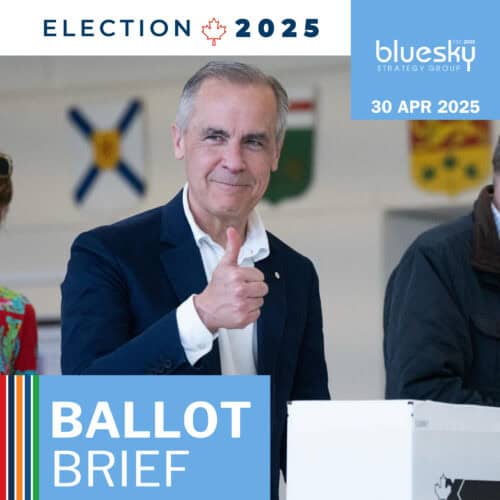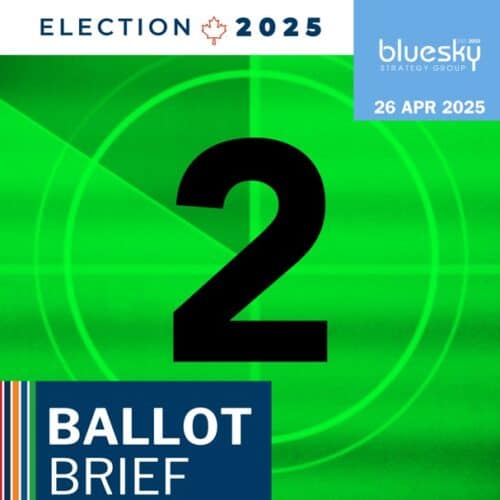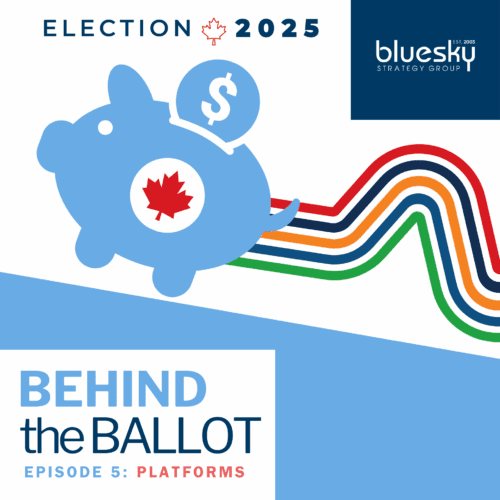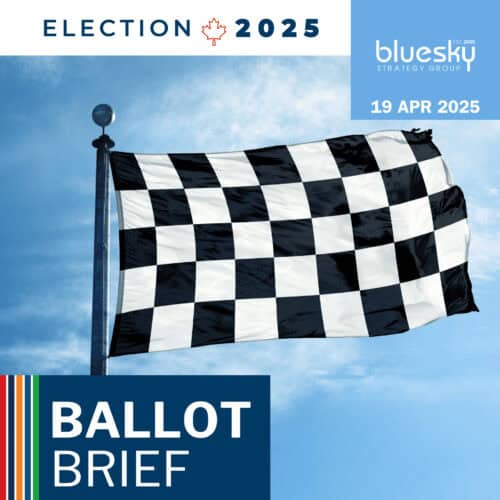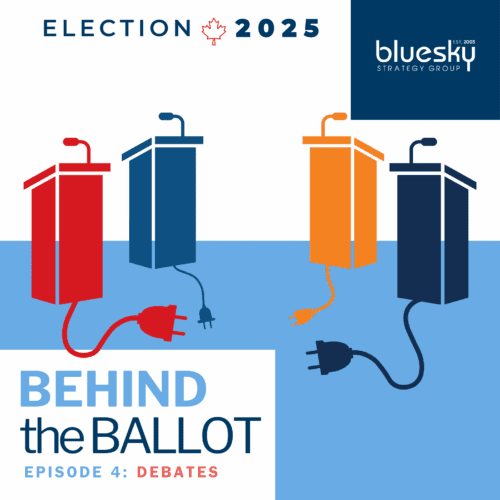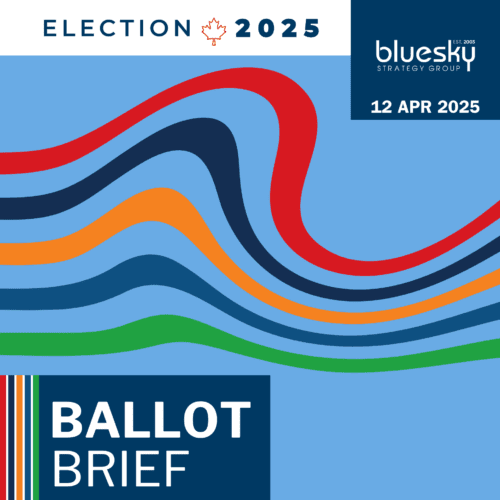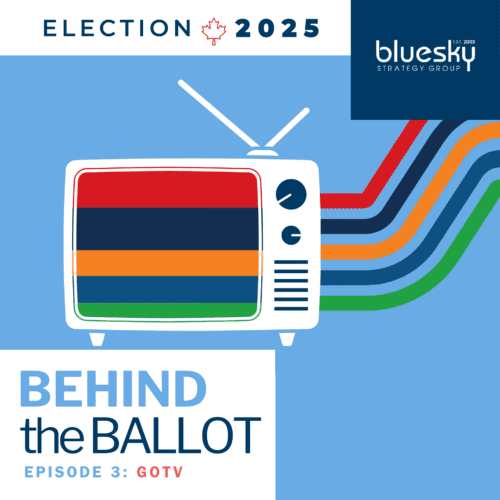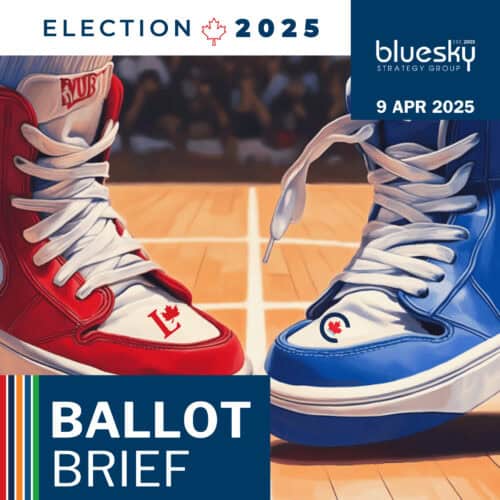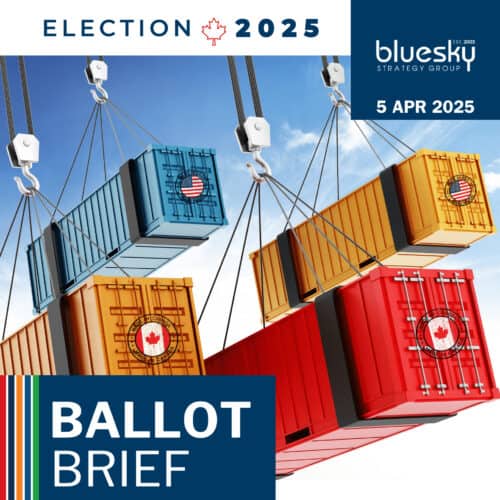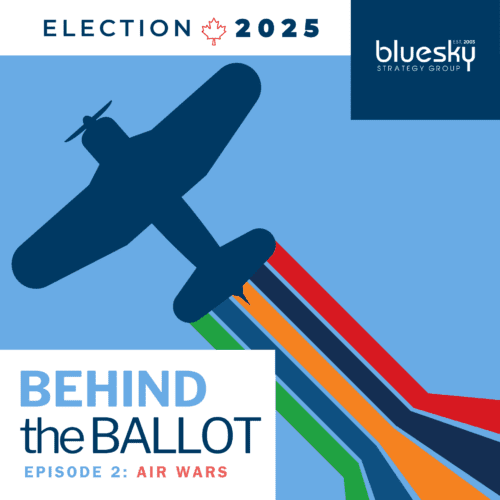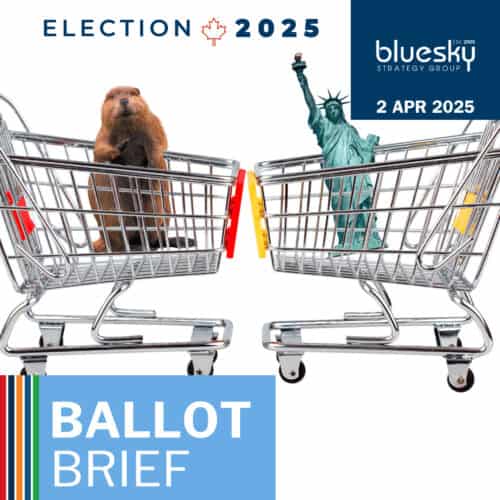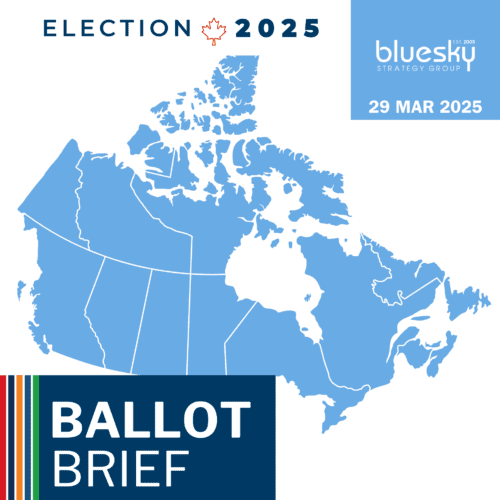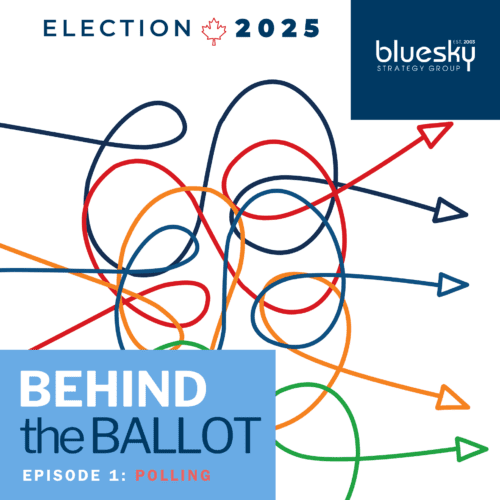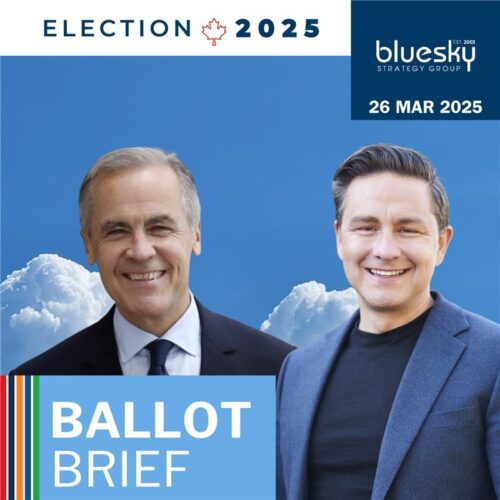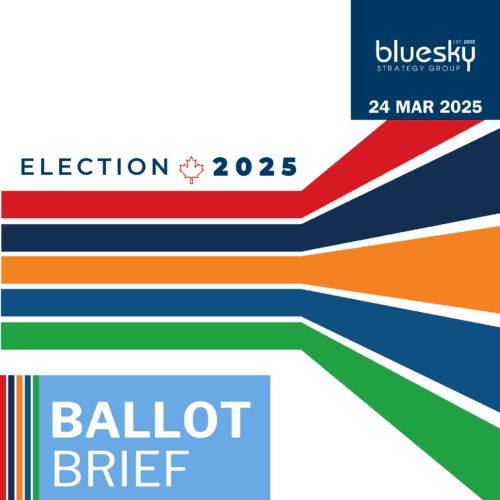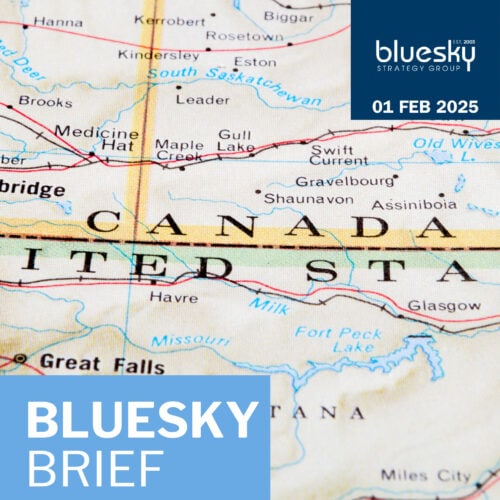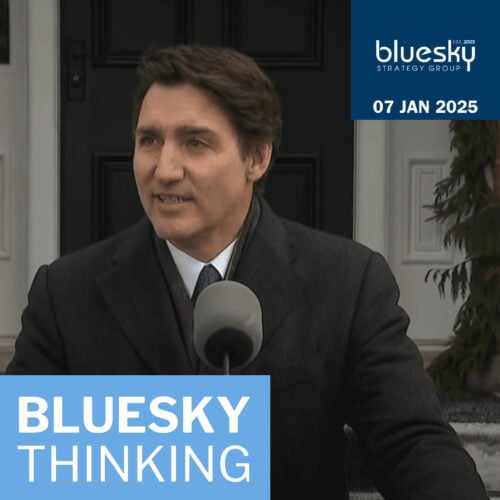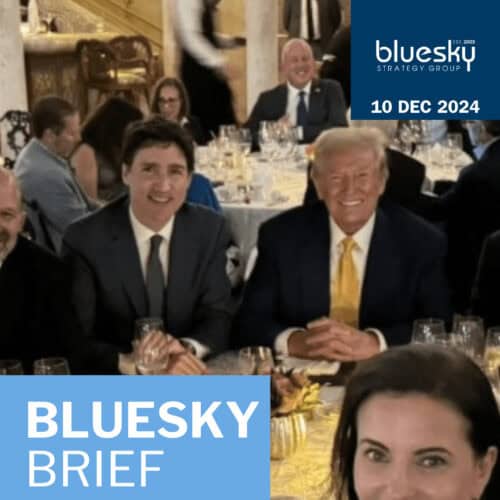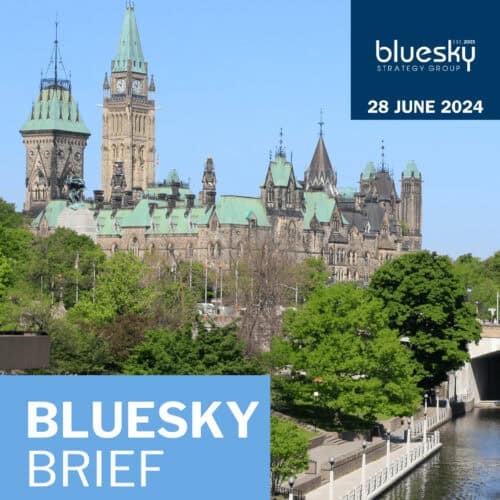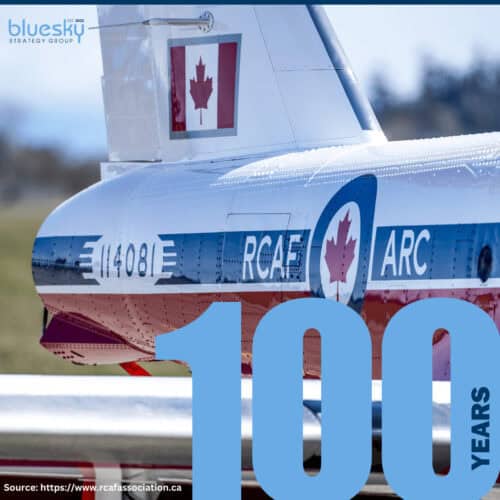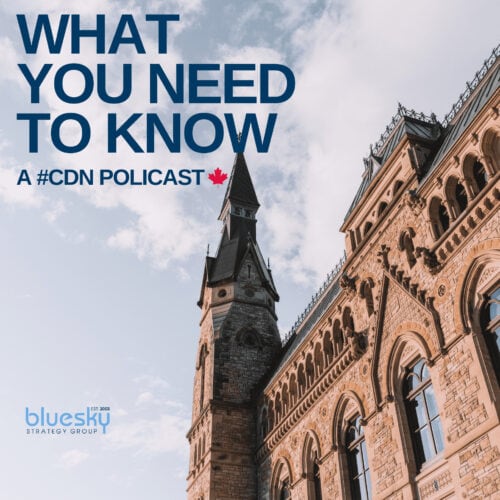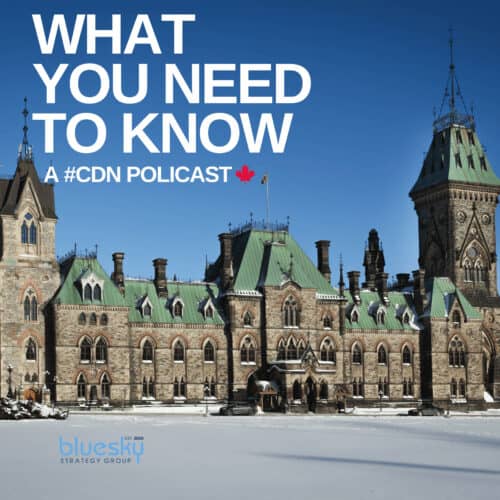Welcome to the post-election edition of Bluesky’s Ballot Brief. After weeks of rallies, debates, and doorknocking, Canadians have made their choice – a minority Liberal government. The political landscape is set and now, the hard work of governing begins. As the dust settles, we look at how the campaigns landed, what the results mean, and where the country and its leaders go from here.
The Rundown
Canada’s political map shifted firmly toward a Liberal-Conservative split. Both major parties expanded their reach with the Liberals bouncing back in Quebec and parts of the West, and the Conservatives tightening their grip on the Prairies and gaining strength in Ontario. Support for third parties like the NDP, Bloc, and Greens fell sharply, plummeting to sub-7 per cent share in the popular vote or less, marking a major shift from the more fragmented elections of the past.
Opposition leader defeated: In a surprise upset, Conservative leader Pierre Poilievre lost his seat in this Ottawa-area suburban/rural riding which he has held for 20 years to Liberal newcomer Bruce Fanjoy who is now being dubbed a “giant killer.” It’s rare for a major party leader to be unseated but Poilievre indicated in his Monday night concession speech that he plans to stay on as leader.
Bloc vs Liberals in Quebec: In Quebec’s battlegrounds, the Bloc Québécois saw multiple seats flip to the Liberals. Several ridings around Montreal and Quebec City that were Bloc in 2021 returned to the Liberal fold, contributing to the Bloc’s 30 per cent seat drop from 32 to the low 20s. Bloc leader Yves-François Blanchet held his seat, but his party will have a much smaller presence.
Close races elsewhere: Several suburban Toronto “905” ridings and Lower Mainland B.C. ridings were tightly contested between Liberals and Conservatives – and at this point, still not decided as counting continues, and some mandatory recounts will be required. The Liberals scored key wins in many of these urban/suburban battlegrounds that were critical to their seat advantage. For example, Liberal candidates picked up seats in areas like Oakville and New Westminster, which had been Conservative or NDP turf last time. Conversely, Conservatives picked off a few formerly Liberal or NDP rural ridings in Ontario and the Prairies. Overall, dozens of races were decided by narrow margins, reflecting a highly competitive two-way fight in much of the country.
Popular Vote: This election marked a historic shift in the popular vote. For the first time since 1930, two parties, the Liberals and the Conservatives, each captured over 40 per cent of the national vote. The collapse of third-party support pushed voters to choose between the two major options, creating a level of polarization and consolidation rarely seen in modern Canadian elections.
Race Recap: Here is what happened in the races that we were watching:
- Burnaby Central: NDP leader Jagmeet Singh loses his seat and will step down as leader.
- Saanich—Gulf Islands: Green party co-leader Elizabeth May is re-elected for a fifth term.
- Calgary Centre: Conservative incumbent Greg McLean was victorious in what was thought to be a highly contested seat.
- Nepean: PM Mark Carney wins with ease to grab a seat in the House of Commons.
- Aurora—Oak Ridges—Richmond Hill: This classic 905 riding elected Conservative Costas Menegakis with a focus on “bread and butter” issues.
- York Centre: Liberal Ya’ara Saks was unseated by former PC Ontario MPP Roman Baber who was kicked out of Ford’s caucus over his opinions on COVID-19 lockdowns.
- Trois-Rivières: Liberal candidate Caroline Desrochers came out on top, beating the Bloc candidate in what many thought was a three-way race.
- Long Range Mountains: The Conservatives gain an additional seat on The Rock with Carol Anstey elected as the new MP, winning over former NTV host Don Bradshaw.
Other Notables:
- Gaspésie—Les Îles-de-la-Madeleine—Listuguj: Long-time Liberal minister Diane Lebouthilier was unseated by the Bloc’s Alexis Deschêne.
- Calgary-McKnight: Liberal George Chahal, widely-expected to find a seat in cabinet, was ousted by the Conservatives Dalwinder Gill in this new riding.
- Edmonton Mayor Amarjeet Sohi hoping to jump back into the federal Liberal ranks lost out to Conservative Jagsharan Singh Mahal in Edmonton Southeast.
- Conservative incumbent Rick Perkins was bumped in South Shore-St. Margarets by Liberal newcomer Jessica Fancy-Landry.
- In a close battle in South Surrey-White Rock, Conservative veteran Kerry-Lynne Findlay was upset by Liberal Ernie Klassen, a White Rock city councillor.
- The NDP’s Peter Julian, who held New Westminster—Burnaby—Maillardville since 2004, became one of his party’s many casualties, falling to Liberal Jake Sawatsky.
The Inside Track
- Mark Carney’s Liberals achieved what, just months ago, seemed almost impossible: victory from the edge of annihilation. A rare convergence of events — the resignation of Prime Minister Trudeau, the political chaos triggered by Trump’s inauguration, and the Conservatives’ inability to capitalize on either, created a constellation of advantages that simply could not have aligned at any other time. The Liberals know it, too. Their focus now must stay squarely on delivering a change in governing style and priorities, fighting back U.S. belligerence, and preparing for the next election, whenever it comes, that will see them in the crosshairs again in seeking now a fifth term. They didn’t win the comfortable majority that would have made that task easier, but it may not be out of reach: just three MPs crossing the floor — from the ruins of the NDP or even the PC wing of the Conservatives — could tip the scales. It’s only speculation for now, but history shows it’s hardly unprecedented in Canadian politics, and there would be enough of a cover story for those turncoats in the face of the existential challenges faced by the nation. In the meantime, survival means urgency, discipline, and continued proof that change wasn’t just a campaign promise.
- Following the election, the Conservative Party is navigating the unusual situation of its leader, Pierre Poilievre, losing his seat. Despite this setback, Poilievre has announced his intention to remain leader, emphasizing the gains made during the campaign, particularly among younger voters and working-class communities. The Conservatives achieved notable breakthroughs, picking up additional seats in the Greater Toronto Area and within Toronto itself, as well as across southern and northern Ontario — including victories in traditionally NDP-held areas. These gains signal a broadening of the party’s appeal in key regions critical for future electoral success. Nonetheless, with Poilievre without a seat in the House of Commons, the CPC will need to appoint an interim Leader of the Opposition, as parliamentary rules require the opposition leader to hold a seat. Meanwhile, Poilievre will face a formal leadership review at the next Conservative Party convention, and potentially sooner if CPC caucus adopts the Reform Act with its powers for MPs to remove the leader. Early signs point to strong internal support for his continued leadership, with many returning caucus members already expressing their backing. Overall, while the election result poses immediate challenges for party operations in Parliament, the Conservatives are positioning themselves to build on their electoral gains with Poilievre at the helm — at least for the time being.
- The NDP enters a harsh new chapter: a severely diminished caucus, no official party status, a discouraged activist base, and a looming leadership vacuum. It could be some time before a successor is chosen, given the unappealing task ahead — little money, few staff, and reduced political influence. In the meantime, working with the Liberals gives the NDP a path to stay relevant. Carney’s commitments to pharmacare and dental care offer a foundation of trust, and early deals are likely to centre on business and worker relief packages more aligned with NDP preferences: support for small businesses over large corporations, and relief for lower-income and vulnerable Canadians. While no longer in a balance-of-power role, the NDP still has opportunities to claim practical wins that resonate with its remaining base and help stabilize during a difficult period of transition.
- Minority memory: having come through two minority parliaments since 2019, all parties are well-practiced in the tactics and politics of navigating this one. The Liberals and NDP have years of experience working together on agreements for confidence measures and key bills and will be able to restart that process to make things work quickly, though the NDP will have significantly less leverage given their inability to fight a snap election any time soon. Meanwhile, the Bloc Québécois and Conservatives — who voted together frequently last Parliament — will likely continue teaming up to apply pressure. While NDP support will be enough to help the Liberals on major votes in the House of Commons, their loss of official party status means a loss of any committee seats — amplifying government’s exposure in those televised and dutifully reported-on spaces. Without an NDP back-up and the Liberals outnumbered for votes, Conservatives and Bloc members will have greater opportunity to drive scandal digging, tactical inquiries, and pressure campaigns on issues the government would otherwise prefer to avoid – but without the voice of their Leader, in the House.
- The weeks ahead will move quickly. A new cabinet is expected to be named within the next 10 to 14 days, followed by Parliament’s return and a Speech from the Throne, likely in the final days of May. Mandate letters flowing from the outlined agenda will signal key priorities heading into a first budget, likely tabled in June, with early legislation focused on worker and small business relief — either as standalone bills or bundled into an omnibus budget package. As president of the G7 summit in Kananaskis this June, Carney will no doubt use it as a platform to project leadership on economic and security priorities. A summer sitting of Parliament may go beyond June, especially if the situation with the U.S. and trade impacts requires more action legislatively or for Parliament to have emergency debates. Another key legislative package could also revolve around interprovincial trade barriers, which have been targeted for elimination by Carney starting in July.
South of the Border
New U.S. Ambassador to Canada has landed: Pete Hoekstra, President Donald Trump’s new U.S. Ambassador to Canada, formally presented his credentials on April 29 to Governor General Mary Simon at Rideau Hall. Hoekstra, who physically arrived in Ottawa on election day, now officially begins his diplomatic role. A close Trump ally and former U.S. Ambassador to the Netherlands, Hoekstra assumes the post at the same time as key negotiations on trade and security are expected to begin.
Trump’s election-day rant: On April 28, as Canadians headed to the polls, President Trump publicly called on voters to support Canada becoming the 51st state. Trump’s unusual direct intervention — rare for a sitting U.S. president regarding a Canadian election — comes in direct contradiction to the result of a re-elected Liberal government with a campaign that focused heavily on standing up against those exact threats. With Trump having openly opposed Carney’s electoral message, the next steps of the relationship between a newly re-elected Canadian government and the White House remain to be seen – with a first meeting expected as one of the first orders of business for the prime minister.
Who’s On First? Post-election, the Prime Minister’s Office released two “readouts” from the first two conversations PM Carney had with world leaders – France’s President Emmanuel Macron and U.S. President Donald Trump. Macron’s was posted before Trump’s. For the latter, the short release noted Trump congratulated Carney on his win and agreed that Canada and the U.S. would work together “as independent, sovereign nations – for their mutual betterment.” Both agreed to meet in person in the near future. Still waiting for the White House readout and Trump’s Truth Social version.
Hot… or Not?
Werk it, sir! While we learned how much Prime Minister Carney loves music through his interview with Nardwuar the Human Serviette earlier in the campaign, last night gave Canadians the opportunity to demonstrate that as our newly-elected Prime Minister, he can bust some moves on the dance floor at his late night victory party in Ottawa.
Dean and “Dame”: In and amongst all the wins and losses and seat flips of the election, there were a couple major milestones that should be noted. The longest serving Member of Parliament, known as the Dean of the House still stands. Bloc MP, Louis Plamondon won his 13th election in a row in the riding of Bécancour-Nicolet-Saurel-Alnôbak. An MP since 1984, as Dean, he gets the honour of overseeing the first order of business in the House – election of the Speaker. And not to be overlooked, Hon. Hedy Fry was re-elected last night in Vancouver Centre. She was first elected in 1993, making headlines as the woman to take down the sitting Prime Minister, Kim Campbell – only the fifth person in Canadian history to take down a sitting PM. Now, with 11 consecutive winning elections under her belt, Hedy is the longest-serving female M.P. and at 83 years of age, she is also the oldest Member of Parliament in the House of Commons – older even than Members of the Senate who have a mandatory retirement age of 75.
The kids are alright: The results are in and according to the students of Canada, we got it a little wrong. Student Vote, held a mock election with 5,900 schools across Canada. More than 900,000 students voted and in their election, it was Pierre Poilievre that won a minority government taking 165 seats, with Carney’s liberals trailing slightly behind with 145 seats.
Class Act: While the election did not go the way NDP Leader Jagmeet Singh had hoped with his Party losing official party status, an 11.6 per cent drop in vote share and Singh himself losing his own seat, he ended it with grace. Singh announced his resignation as Leader of the New Democrats Monday night during his concession speech, taking pains to thank everyone who campaigned with him, including his wife whom he joked he has regretted for years that he failed to thank her on the night of the last election. Visibly emotional, Singh held it together with some touches of humor and frequent pauses to drink from several glasses of water as he collected himself.
Bluesky Bonus
Bluesky On the Air: It was a big night, at home and abroad, for Team Bluesky on election night. Vice-President Geoff Turner joined CTV News Channel before polls closed to set the stage,
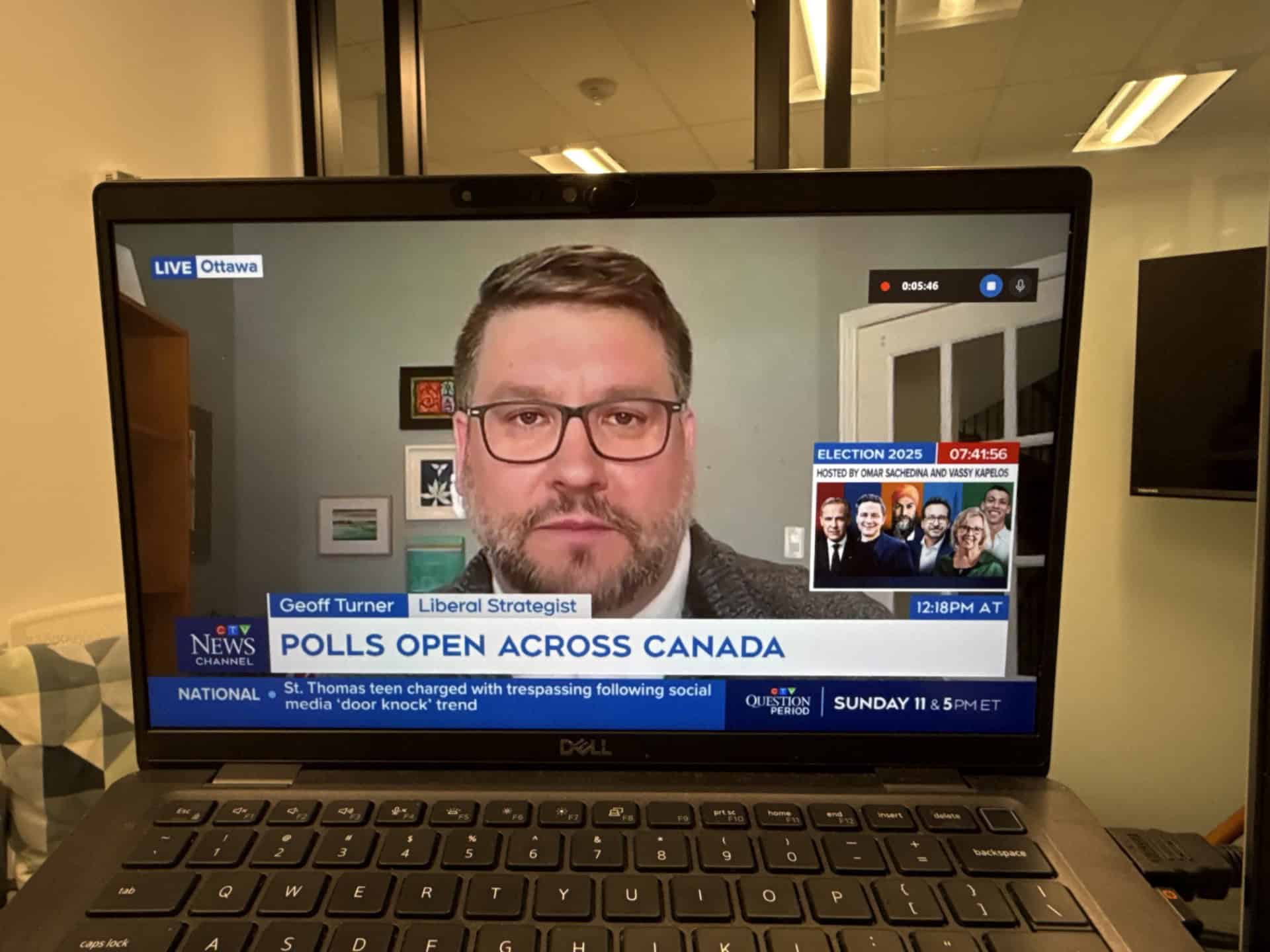
while Principal Susan Smith provided live analysis on CPAC’s election night coverage and was back the next day appearing on CBC’s The Current, and CTV News.
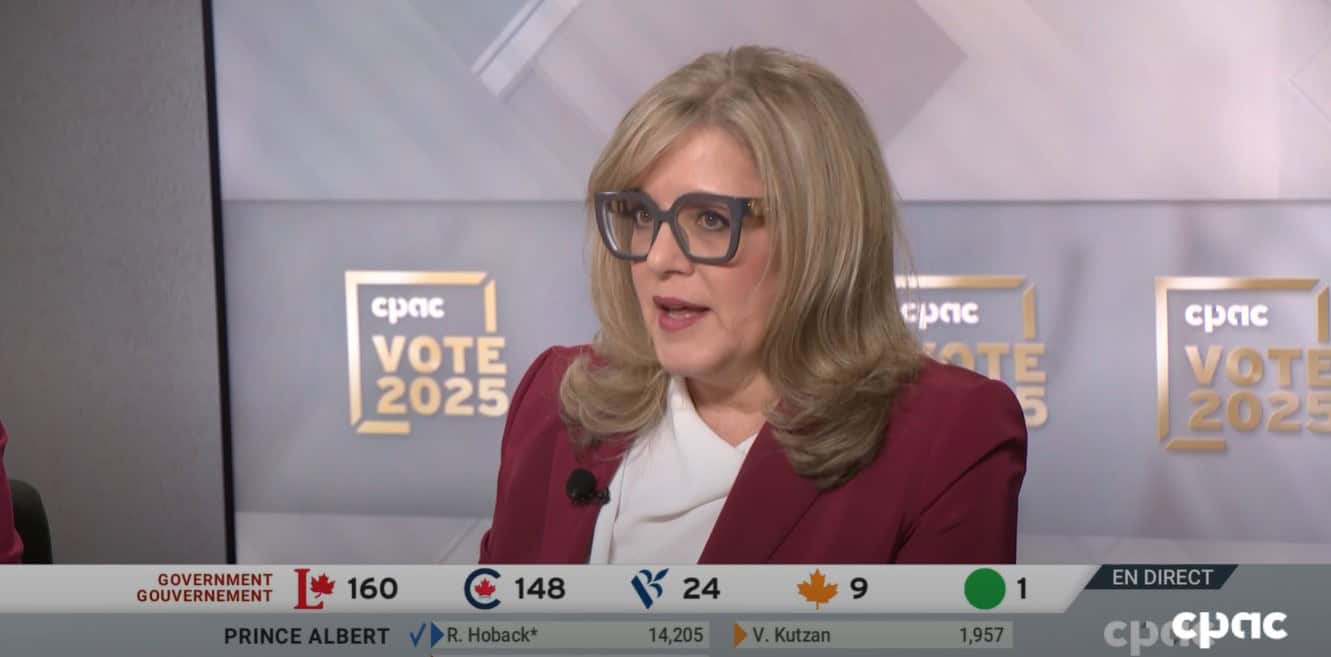
Senior Consultant Alyson Fair weighed in on Rogers TV’s Ottawa coverage,
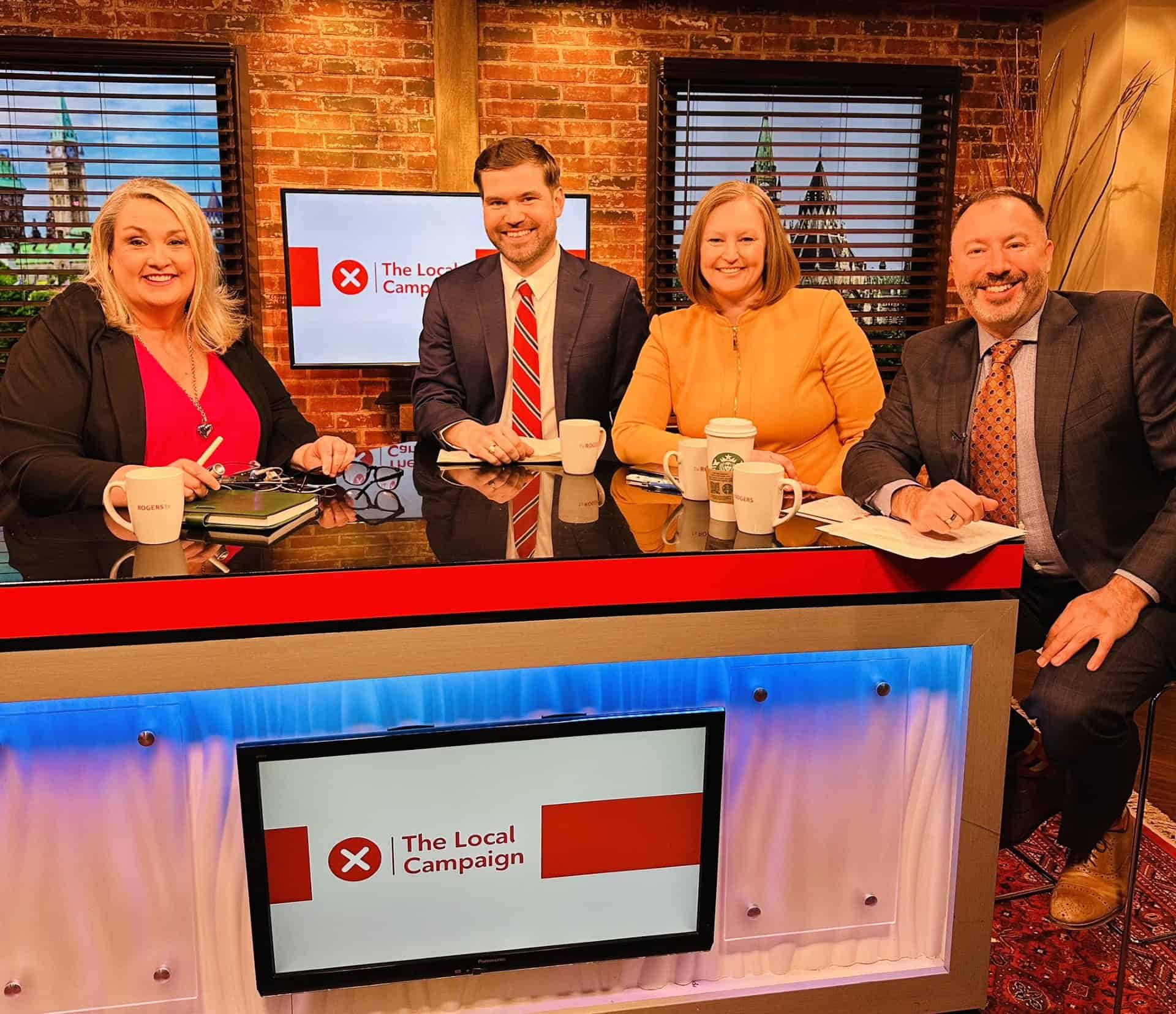
and Bluesky voices even went international, with Vice-President Raphael Brass on Sky News
